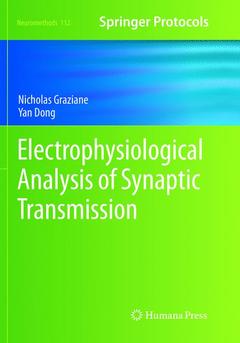Electrophysiological Analysis of Synaptic Transmission, Softcover reprint of the original 1st ed. 2016 Neuromethods Series, Vol. 112
Auteurs : Graziane Nicholas, Dong Yan

Overview: Electrophysiology: Strength and Limitation
Part One: Basic Concepts
Chapter 1: Extracellular and intracellular recordings
Chapter 2: Electrical theory
Chapter 3: Amplifiers
Chapter 4: Salt environment
Chapter 5: Electrodes
Chapter 6: Spatiotemporal effects of synaptic current
Chapter 7: Perforated patch
Part Two: Recording of synaptic current
Chapter 8: Isolation of synaptic current
Chapter 9: Fast and slow synaptic currents
Chapter 10: Measuring kinetics of synaptic current.
Chapter 11: Measuring presynaptic release probability
Chapter 12: Long-term measurements
Chapter 13: Measuring reversal potentials
Part Three: Basic Experimentations of synaptic transmission
Chapter 14: Amplitude
Chapter 15: Pre vs. post synaptic effect
Chapter 16: Runup and rundown
Chapter 17: Kinetics of synaptic current
Part Four: Experimentations with computational componentsChapter 18: Measurement of a single synapse
Chapter 19: Measurement of silent synapses
Chapter 20: Dendritic patch
Part Five: Experimentations with molecular and visual components
Chapter 21: Electrophysiological and visual tags
Part Six: In vivo Recordings
Chapter 22: Extracellular recordings
Nicholas M. Graziane, Ph.D.
Dr. Graziane obtained his Ph.D. from The State University of New York at Buffalo, and did his first postdoctoral training at Brown University before joining Dr. Dong’s laboratory at University of Pittsburgh. He is a well-published electrophysiologist interested in neurocircuits implicated in psychiatric disease with a focus on the electrical properties of the neurons residing within these neurocircuits. His research interests have contributed to Dr. Graziane’s 10+ years of experience as an electrophysiologist and have enabled him to successfully train many undergraduate students, graduate students, and junior postdoctoral fellows who have been interested in beginning a career in electrophysiology. Currently, Dr. Graziane’s research focuses on synaptic and circuitry mechanisms underlying psychiatric and psychological disorders. He is funded through a National Research Scholar Award (NIH).
Yan Dong, Ph.D.
Dr. Dong became interested in brain function when he was in high school and started his electrophysiological training during college. He received his Ph.D. from the Chicago Medical School, and did his postdoctoral training at Stanford University. He established and supervised his first independent laboratory at Merck and Co. from 2004 to 2006 as a senior scientist. He then joined Washington State University as an assistant professor in the Program of Neuroscience. In 2012, he joined University of Pittsburgh, and is curr
ently an associate professor in the Department of Neuroscience. His research focuses on synaptic and circuitry mechanisms underlying psychiatric and psychological disorders. His research has been supported by National Institutes of Health (US), Hope Foundation for Depression Research (US), and Humboldt Stiftung (Germany).A practical guide to electrophysiological manipulations and assays in brain research
A best-practices guide for collecting and interpreting data
Intended for senior undergraduates and above?
Includes supplementary material: sn.pub/extras
Ouvrage de 263 p.
17.8x25.4 cm
Ouvrage de 263 p.
17.8x25.4 cm
Thème d’Electrophysiological Analysis of Synaptic Transmission :
Mots-clés :
analysis; brain; electrophysiology; methods; patch-clamp; synapse



